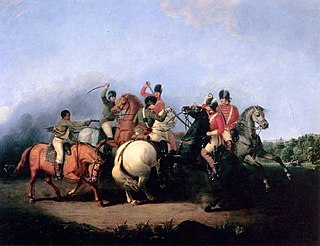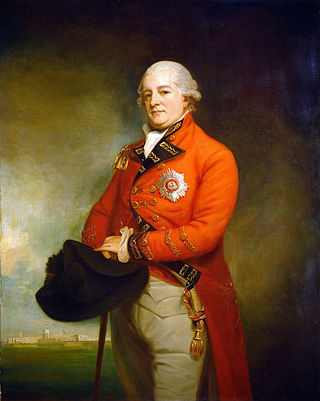
Oglethorpe's Regiment of Foot was an infantry regiment of the British Army formed for service in North America during the War of Jenkins' Ear. It was commanded by James Oglethorpe, first Governor of Georgia. [1] [2] [3]

Oglethorpe's Regiment of Foot was an infantry regiment of the British Army formed for service in North America during the War of Jenkins' Ear. It was commanded by James Oglethorpe, first Governor of Georgia. [1] [2] [3]
The raising of the regiment, ranked as the 42nd Regiment of Foot, was authorised in August 1737. The unit formed at Savannah in the following year. [1] [4]
They took part in the Siege of St Augustine in June and July 1740 and the Battles of Bloody Marsh and Gully Hole Creek near Fort Frederica in July 1742. [1] [2] [3]
The regiment was disbanded at the end of the conflict on 24 November 1748. [1] Some of its discharged soldiers enlisted in the South Carolina Independent Companies. [5] [6]

The Province of Georgia was one of the Southern colonies in British America. It was the last of the thirteen original American colonies established by Great Britain in what later became the United States. In the original grant, a narrow strip of the province extended to the Pacific Ocean.
The Battle of Alligator Bridge took place on June 30, 1778, and was the only major engagement in an unsuccessful campaign to conquer British East Florida during the American Revolutionary War. A detachment of Georgia militiamen under the command of General James Screven chased Thomas Brown's Loyalist company into a large position of British regulars established by British Major Mark Prevost and were turned back.

The Castillo de San Marcos is the oldest masonry fort in the continental United States; it is located on the western shore of Matanzas Bay in the city of St. Augustine, Florida.

The Battle of the Rice Boats, also called the Battle of Yamacraw Bluff, was a land and naval battle of the American Revolutionary War that took place in and around the Savannah River on the border between the Province of Georgia and the Province of South Carolina on March 2 and 3, 1776. The battle pitted the Patriot militia from Georgia and South Carolina against a small fleet of the Royal Navy.

The siege of Savannah or the Second Battle of Savannah was an encounter of the American Revolutionary War (1775–1783) in 1779. The year before, the city of Savannah, Georgia, had been captured by a British expeditionary corps under Lieutenant-Colonel Archibald Campbell. The siege itself consisted of a joint Franco-American attempt to retake Savannah, from September 16 to October 18, 1779. On October 9 a major assault against the British siege works failed. During the attack, Polish nobleman Count Casimir Pulaski, leading the combined cavalry forces on the American side, was mortally wounded. With the failure of the joint attack, the siege was abandoned, and the British remained in control of Savannah until July 1782, near the end of the war.

The Battle of Cowpens was an engagement during the American Revolutionary War fought on January 17, 1781 near the town of Cowpens, South Carolina, between U.S. forces under Brigadier General Daniel Morgan and British forces under Lieutenant Colonel Banastre Tarleton, as part of the campaign in the Carolinas. The battle was a turning point in the American reconquest of South Carolina from the British.

Amelia Island is a part of the Sea Islands chain that stretches along the East Coast of the United States from South Carolina to Florida; it is the southernmost of the Sea Islands, and the northernmost of the barrier islands on Florida's Atlantic coast. Lying in Nassau County, Florida, it is 13 miles (21 km) long and approximately 4 miles (6.4 km) wide at its widest point. The communities of Fernandina Beach, Amelia City, and American Beach are located on the island.

The Battle of Bloody Marsh took place on 7 July 1742 between Spanish and British forces on St. Simons Island, part of the Province of Georgia, resulting in a victory for the British. Part of the War of Jenkins' Ear, the battle was for the British fortifications of Fort Frederica and Fort St. Simons, with the strategic goal the sea routes and inland waters they controlled. With the victory, the Province of Georgia established undisputed claim to the island. It is now part of the U.S. state of Georgia. The British also won the Battle of Gully Hole Creek, which took place on the island the same day.
The Battle of Thomas Creek, also known as the Thomas Creek Massacre, was an ambush of a small detachment of mounted Georgia Militia by a mixed force of British soldiers, Loyalist militia, and British-allied Indians on May 17, 1777 near the mouth of Thomas Creek in northern East Florida. The encounter was the only major engagement in the second of three failed attempts by American forces to invade East Florida in the early years of the American Revolutionary War.

Fort King George State Historic Site is a fort located in the U.S. state of Georgia in McIntosh County, adjacent to Darien. The fort was built in 1721 along what is now known as the Darien River and served as the southernmost outpost of the British Empire in the Americas until 1727. The fort was constructed in what was then considered part of the colony of South Carolina, but was territory later settled as Georgia. It was part of a defensive line intended to encourage settlement along the colony's southern frontier, from the Savannah River to the Altamaha River. Great Britain, France, and Spain were competing to control the American Southeast, especially the Savannah-Altamaha River region.

The Capture of Savannah, or sometimes the First Battle of Savannah, or the Battle of Brewton Hill, was an American Revolutionary War battle fought on December 29, 1778 pitting local American Patriot militia and Continental Army units, holding the city, against a British invasion force under the command of Lieutenant Colonel Archibald Campbell. The British capture of the city led to an extended occupation and was the opening move in the British southern strategy to regain control of the rebellious Southern provinces by appealing to the relatively strong Loyalist sentiment there.

The Battle of Fort Mose was a significant action of the War of Jenkins' Ear that took place on June 14, 1740 in Spanish Florida. Captain Antonio Salgado commanded a Spanish column of 300 regular troops, backed by the free black militia under Francisco Menéndez and allied Seminole warriors consisting of Indian auxiliaries. They stormed Fort Mose, a strategically crucial position newly held by 170 British soldiers under Colonel John Palmer. Palmer and his garrison had taken the fort from the Spanish as part of James Oglethorpe's offensive to capture St. Augustine.

James Edward Oglethorpe was a British soldier, Member of Parliament, and philanthropist, as well as the founder of the colony of Georgia in what was then British America. As a social reformer, he hoped to resettle Britain's "worthy poor" in the New World, initially focusing on those in debtors' prisons.
John Gordon was a Loyalist British merchant and trader of Scottish origin who lived in South Carolina for many years. He settled in Charles Town about 1760, and from 1759 to 1773 he was a major exporter of deerskins supplied by Native American hunters. Gordon also participated in the transatlantic slave trade but was not a major importer of captive Africans.

Fort St. Andrews was a British colonial coastal fortification built on Cumberland Island, Georgia, in 1736. The fort was built by the British as part of a buffer against Spanish Florida and the colonies to the north. The fort was abandoned and later destroyed by the Spanish in mid-1742.

Gooch's American Regiment was a Regiment of Foot recruited in British North America, and put on the British establishment. It served in the expedition to Cartagena 1741, suffering heavy losses primarily from sickness. The regiment had a poor reputation and was regarded as undisciplined. It was severely neglected by the British government, and by the British military leadership, who did not feed or pay them at the base in Jamaica, and misused them as seamen during the expedition.

Provincial troops were military units raised by colonial governors and legislatures in British North America for extended operations during the French and Indian Wars. The provincial troops differed from the militia, in that they were a full-time military organization conducting extended operations. They differed from the regular British Army in that they were recruited only for one campaign season at the time. These forces were often recruited through a quota system applied to the militia. Officers were appointed by the provincial governments. During the eighteenth century militia service was increasingly seen as a prerogative of the social and economic well-established, while provincial troops came to be recruited from different and less deep-rooted members of the community.

British Army Independent Companies in South Carolina formed a major component of the Province of South Carolina's military security. Regular independent companies were first established in British North America in 1664. The first Independent Company in South Carolina was organized in 1721. With the raising of Oglethorpe's Regiment in 1737 it was disbanded. In 1746 three understrength independent companies were sent to South Carolina, but they were disbanded two years later. When Oglethorpe's Regiment was disbanded in 1748, three new independent companies were raised in South Carolina, partly recruited with soldiers from the disbanded regiment. These three companies participated in the French and Indian War and the Cherokee War, participating in the Battle of Fort Necessity, the Braddock Expedition, the battle of the Monongahela, and the siege of Fort Loudoun. They were disbanded in 1763, with the rest of the British army independent companies in North America.

Fort San Francisco de Pupo was an 18th-century Spanish fort on the west bank of the St. Johns River in Florida, about eighteen miles from St. Augustine, the capital of Spanish Florida. Lying on the old trail to the Spanish province of Apalachee in western Florida, Fort Pupo and its sister outpost, Fort Picolata on the opposite shore of the river, controlled all traffic on the ferry crossing. The remains of Fort Pupo are situated about three miles south of Green Cove Springs in Clay County, near the end of Bayard Point opposite Picolata. The surrounding area is a hammock of southern live oak, southern magnolia, pignut hickory and other typical trees native to the region.